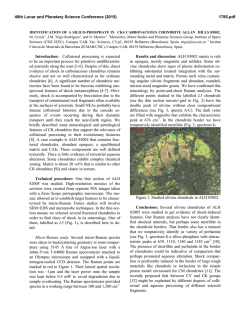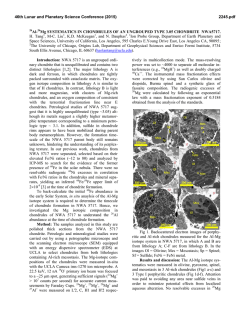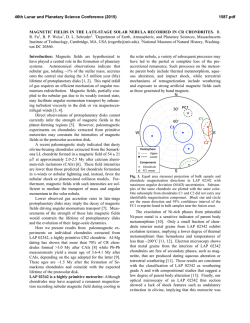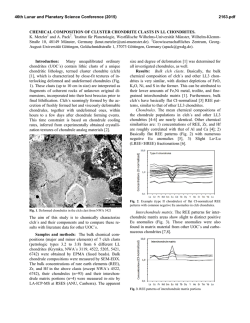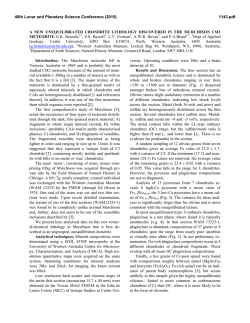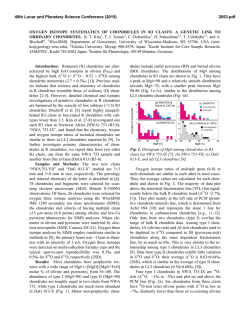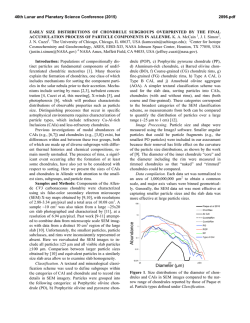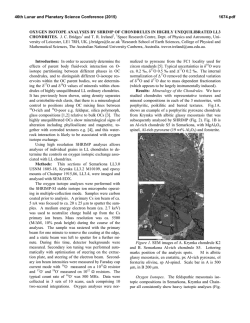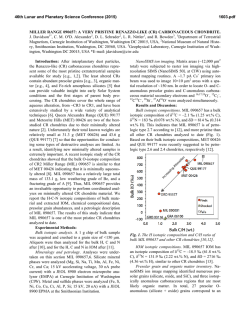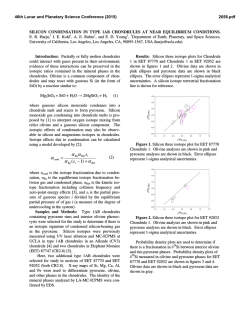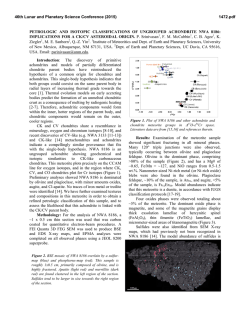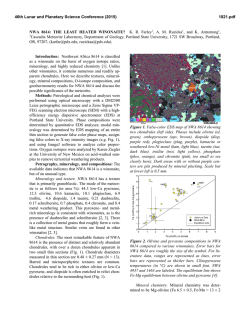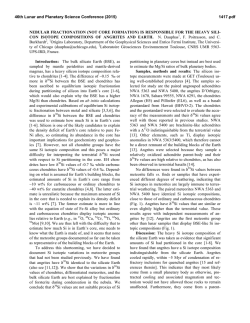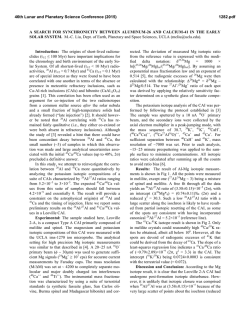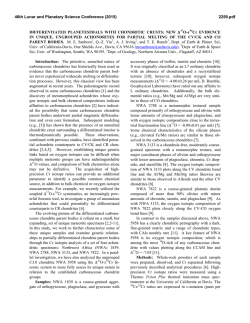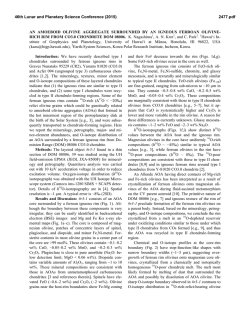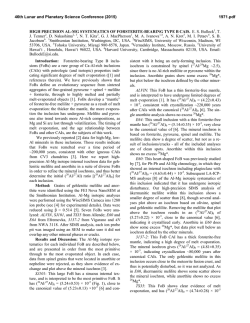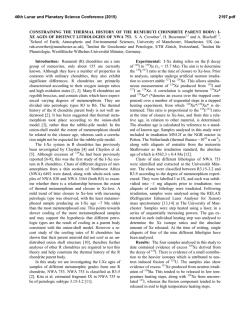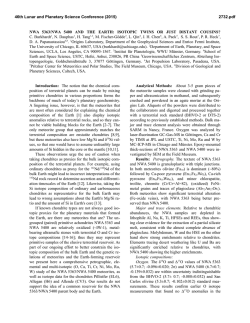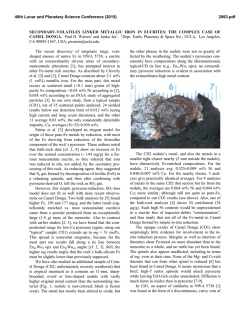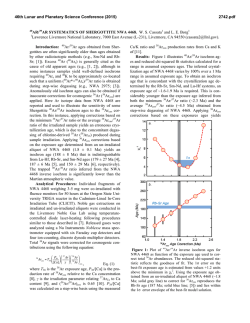
I-Xe System in Chondrules from CR2 Chondrite NWA 721
46th Lunar and Planetary Science Conference (2015) 2926.pdf I-Xe SYSTEM IN CHONDRULES FROM CR2 CHONDRITE NWA 721. O. V. Pravdivtseva1, A. P. Meshik1, C. M. Hohenberg1 and A. N. Krot2, 1Physics Department, Laboratory for Space Sciences, Washington University, St. Louis MO 63130, USA ([email protected]), 2University of Hawai’i at Manoa, Honolulu, HI 96822, USA. Introduction: CR carbonaceous chondrites are among the most primitive meteorites in our collections [1, 2]. Although they experienced various degrees of aqueous alteration, most of them avoided thermal and shock metamorphism, and, therefore, could have preserved primary isotopic records in their components. The previously reported 26Al-26Mg systematics of CR chondrules [3–5] indicate that only ~35% of them show resolvable excesses of 26Mg*. The inferred initial 26Al/27Al ratios [(26Al/27Al)0] in CR chondrules range from (1.0±0.4)×106 to (6.3±0.9)×106 [3–5] which is significantly lower than (26Al/27Al)0 in the majority of chondrules from UOCs, COs, and Acfer 094 [6, 7]. Assuming homogeneous distribution of 26Al in the protoplanetary disk at the canonical level [(26Al/27Al)0 ~ 5.2×10‒5], the inferred (26Al/27Al)0 in CR chondrules imply that they represent several generations; the majority characterized by low (26Al/27Al)0 (<3×106) [3–5]. A weighted mean (26Al/27Al)0 of 22 CR chondrules corresponded to a formation age of 3.4 (+0.2, -0.1) Myr after CV CAIs [4]. Here we present I-Xe isotope systematics of 5 chondrules from the CR2 chondrite NWA 721. The IXe systematics is known to be affected by aqueous alteration [8], and thus can potentially provide information on the onset of aqueous alteration in the CR chondrites, which is still poorly constrained [9, 10]. Chondrules were split into fragments, thus I-Xe and Pb-Pb systematics in the same chondrule could be potentially studied in the future. Results and Discussion: Three of the studied NWA 721 chondrules, #1, #2, and #3 (Table 1) are of the most abundant type I, (magnesium-rich, porphyritic olivine-pyroxene). Two of them are surrounded by coarse-grained igneous rims, typical for CR chondrules (Fig. 1). Two chondrules, A3 and X are anorthite-rich; they consist of low- and high-Ca pyroxenes, anorthitic plagioclase, olivine, Cr-bearing spinel, FeNi-metal, and crystalline mesostasis. In order to convert 127I into 128Xe, samples were irradiated at the University of Missouri Research Reactor receiving 2×1019 thermal neutrons/cm2. Xenon was extracted by step-wise pyrolysis in a low blank W-coil, and its isotopic composition was measured using BaurSigner discrimination-free ion source massspectrometer. Fig. 1. Combined x-ray elemental map in Mg (red), Ca (green), Al K (blue) of chondrule #2 from the CR chondrite NWA 721. The chondrule consists of magnesian olivine (ol), low-Ca pyroxene (px), glassy mesostasis (mes), high-Ca pyroxene (cpx), and Fe,Nimetal nodules (met). It is surrounded by a coarsegrained igneous rim (IR). Table 1. Summary of data obtained from samples of 5 NWA 721 chondrules. 132 Xe weight 129*Xe 128*Xe 131*Xe chd# trapped fission (mg) ‒10 3 A3 X 1 2 3 3.50 5.90 1.43 1.73 8.92 0.001 0.001 0.001 0.007 0.001 ×10 cm STP/g 16.15 7.93 0.44 7.52 12.54 4.15 8.39 65.11 31.40 7.71 3.18 0.19 0.40 3.72 2.18 0.22 0.11 0.30 0.10 0.10 Concentrations of radiogenic 129*Xe, 128*Xe, 131*Xe, and fission 132Xe (Table 1) represent excesses over ordinary chondrites (OC) Xe trapped component. 129* Xe and 128*Xe are derived from iodine, 131*Xe is from neutron capture on 130Ba and/or 130Te. Rare earth element abundances in plagioclase in a single anorthite-rich Renazzo CR chondrule were shown to be 20 times of the CI chondrites value [1]. As a result barium appears to be the more probable parent for 131* Xe. All NWA 271 chondrules contain compatible concentrations of U-fission xenon. Four of the NWA 721 chondrules studied here have no detectable 129*Xe. 46th Lunar and Planetary Science Conference (2015) Only one chondrule, c #2,, shows slight excess of 129Xe X at 150016 600C extractio on step. Similaar release patterrn is observed d for chondrulle #1, although h the concentrration of 129**Xe in this casse is even loweer, within 2 of o OC-Xe vallue. We usu ually present data d as three-issotope diagram ms, where 129Xe/ X 132Xe is plo otted versus 128Xe/132Xe aftter correction for fission Xe. Extractio on steps where 129 Xe/129Xee ratio is constant form a straight s line, an a isochron, that t correspond ds to the I-Xee system closu ure time. We cannot c define an isochron baased on one ex xperimentall point, but forr the NWA 72 21 chondrule #2 # the slope of o the line drawn through th he 15001600C extraction and OC trapp ped componentt points suggeest s in this chondrule may y have closed at that I-Xe system 11 Myr after a CV CAIss. This is conssistent with esttimation forr aqueous pro ocessing at 2 213 Myr aftter CAIs based on Mn-Cr ag ges of carbonaate grains in ReR nazzo and GRO 95577 [1 10]. It is kn nown that CR chondrites c expeerienced variou us degrees off aqueous alteeration at temp peratures belo ow 100150C C [1,11]. App parently, iodinee in NWA 72 21 chondruless studied was nearly compleetely lost durin ng aqueous alteration, a for all studied ch hondrules more than 90% of radiogenicc 128*Xe was released belo ow 1100C (98% for chondrrule #2, Fig. 2), consistent with on of losses an nd superficial iodine contam micombinatio nation. Fig. 2. Reelease profiless of radiogenicc 128*Xe, 131*Xe X and d trapped OC--Xe componen nt in NWA72 21 cho ondrule #2. It was shown that O-isotopic O com mposition corrrelates with the degree off alteration in n CR chondritees [13, 14] and a the anhyd drous compon nents, includin ng FeO-poor chondrules, most likely repreesent primordiial CR chondrrite parent bod dy, before thee alteration too ok place. If so, the least aq queously altereed CR3.0 chon ndrites, e.g.., QUE 99177 and MET 00 0426 [2, 13, 14 4] could be more m promisin ng candidates for f the I-Xe dad ting of cho ondrule ages. 2926.pdf Sup upported by NA ASA grant NNX X14A124G. Reeferences: [1] K Krot A. N. et al. (2002) Meeteoritics & P Planetary Scieence, 37, 1451––1490. [2] Abbreu N. M. andd Brearley A. J. (2010) Geochimica et C Cosmochimicca Acta, 74, 11146–1171. [3] Nagashima K. et al. (2014)) Geochemicall Journal, 48. [[4] Schrader D D. L. et al. (20013) 76th Meteeoritical Socieety Meeting, A A5141. [5] Tennner T. J. et all. (2013) 44th L Lunar and Planetary Sciencce Conference,, Abst. #2010. [6] Villeneuvve J. et al. (20009) Science, 3325, 985–988. [7] Ushikuboo et al. (2013)) Geochimica et Cosmochim mica Acta, 109, 280– 295. [88] Hohenberg C. M. and Praavdivtseva O. ((2008) Chemiie der Erde, 688, 337–450. [99] Tyra M. A., et al. (2010)) 41st Lunar and Planetary Science Confeerence, Abst. #2614. [10] Jiilly C. E. et al. (2013) 44th Lunar and P Planetary Sciennce Conferencee, Abst. #24744. [11] Weisbberg M. K. et al. (1993) Geochimica et C Cosmochimicca Acta, 57, 15563–1586. [12] Weisberg M. K. et al. (19995) Proceedinngs of NIPR Syymposium on A Antarctic Meeteorites, 8, 11‒32. [13] Chooi B. G. et al. ((2009) Meteorritical Society Meeting, A5339. [14] Schraader D. L. et aal. (2011) Geocchimica et Cossmochimica Accta, 75, 308–3225.
© Copyright 2024
